Iran has assassinated its enemies across four continents — in Asia, Europe, North America and South America — over the four decades since the 1979 revolution. As of 2023, the Islamic Republic had reportedly assassinated at least 20 opponents abroad and killed hundreds in bombings of foreign military, diplomatic and cultural facilities. It targeted Americans, Europeans, Latin Americans, Israelis and Arabs as well as Iranian opposition members living abroad, according to U.S., U.N., Israeli and other government reports. They included at least 88 attacks or plots:
- 21 targeted Iranian dissidents
- 35 targeted Israelis or Jews
- 25 plots were against Western targets
- 8 plots were against Arab or other regional targets
“Terrorism is an important instrument of Iranian foreign policy, used both to promote national interests and to export the regime’s revolutionary ideals,” a declassified CIA report from 1987 said. Some assassinations suggested methodical planning.
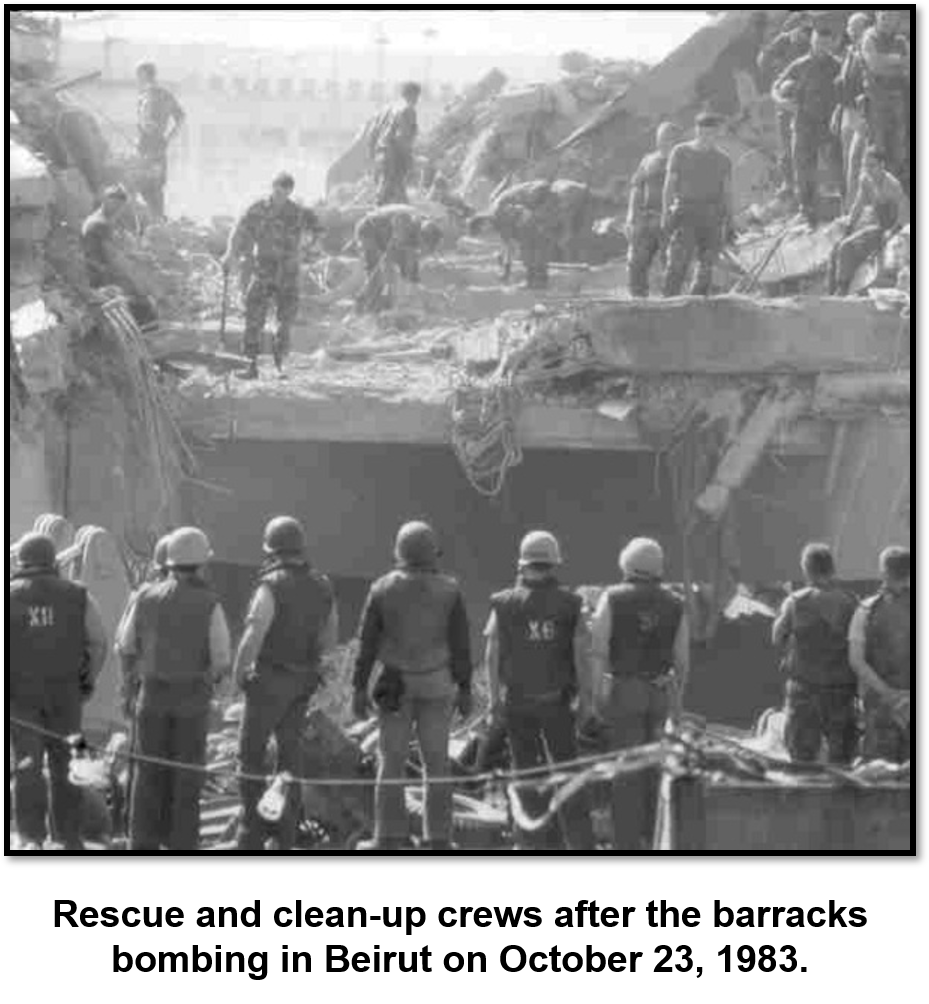 The Qods Force, the elite wing of the Islamic Revolutionary Guard Corps (IRGC) that operates outside Iran, has been linked to most of the attacks or plots, the reports concluded. It has coordinated with or used local proxies, such as Lebanon’s Hezbollah, in many attacks. They were linked in the 1983 bombing of U.S. peacekeepers in Lebanon, which killed 241 Marines.
The Qods Force, the elite wing of the Islamic Revolutionary Guard Corps (IRGC) that operates outside Iran, has been linked to most of the attacks or plots, the reports concluded. It has coordinated with or used local proxies, such as Lebanon’s Hezbollah, in many attacks. They were linked in the 1983 bombing of U.S. peacekeepers in Lebanon, which killed 241 Marines.
The Foreign Ministry’s Department 210 reportedly also facilitated the operations or coordinated with Iranian intelligence services. In August 1991, Shapour Bakhtiar, Iran's last prime minister during the monarchy, was killed by two men who were allegedly Iranian intelligence agents. The Foreign Ministry reportedly issued the two men passports with false names so they could pose as businessmen and then helped them acquire visas to France.
But many alleged plots failed due to poor planning or amateur operatives. One of the most bizarre attempts was a plan in 2011 to kill the Saudi ambassador to the United States at a restaurant in Washington. A used car salesman from Corpus Christi, Texas allegedly tried to hire a Mexican drug gang to carry out the hit. Earlier that year, an alleged Iranian operative in Thailand accidentally blew his legs off with a bomb that detonated while he was trying to escape from the police.
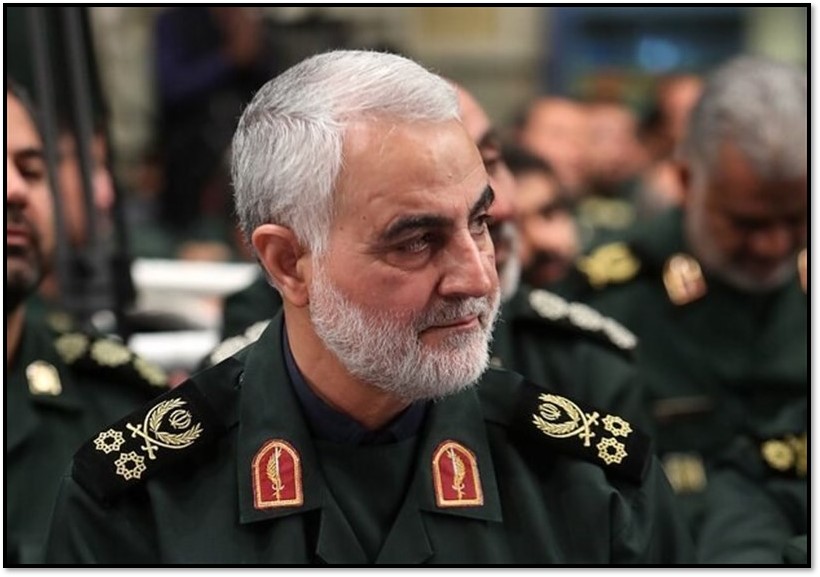
Both Republican and Democratic administrations have denounced Iran’s assassinations and bombings. In May 2013, Wendy Sherman, the Under Secretary for Political Affairs under President Barack Obama, condemned Iran’s “heinous acts of terrorism” in testimony to the Senate Foreign Relations Committee. “The attempt to assassinate a foreign diplomat in our nation’s capital is an intolerable escalation of Iranian terrorist activity.”
In April 2020, Secretary of State Mike Pompeo called Iranian diplomats “agents of terror” and accused them of carrying out “multiple assassinations and bomb plots.” In September 2020, Politico reported that Iran was plotting to kill Lana Marks, the U.S. ambassador to South Africa and a close friend of President Donald Trump. It claimed that Iran was weighing several options to retaliate for the U.S. killing of General Qassem Soleimani in January 2020.
Iran denied the Politico report. “Such baseless remarks are part of the Trump administration’s counter-intelligence campaign against Iran,” Foreign Ministry Spokesman Saeed Khatibzadeh said. The Revolutionary Guards insisted that any retaliation for Soleimani's death would be "honorable" and would not involve the U.S. ambassador. "We will target those who were directly or indirectly involved in the martyrdom of [Soleimani]," IRGC chief Hossein Salami said.
After the report, Trump threatened retaliation “1,000 times greater in magnitude” for any attack against U.S. officials. Pompeo dismissed reports that killing Soleimani had put the ambassador at greater risk. South Africa said that the information provided by U.S. officials was "not sufficient" to suggest a "credible threat" against Marks and requested more intelligence on the alleged plot. "Once the information is forthcoming, the facts will be reviewed and re-assessed," the State Security Agency said.
In August 2022, the Justice Department announced charges against a member of the Revolutionary Guards, Shahram Poursafi, for plotting to murder John Bolton, a national security advisor to President Trump. Former Secretary of State Mike Pompeo and former Defense Secretary Mark Esper were reportedly also targeted by Iran. All three were under around-the-clock government protection. “We face a concerted threat to America itself, not unconnected threats to random individuals. Iran does not fear U.S. deterrence,” Bolton wrote in The Washington Post.
In July 2023, Israeli Defense Minister Yoav Gallant warned that Iran had led “a worldwide terror campaign” with “unprecedented scope, targeting Israelis and Jews” worldwide. “There have been more than 50 attempted attacks in recent years,” he said. “Most of them were ready to go and were foiled at the last moment.” Israel “foiled these attempts and saved lives” partially “thanks to the understanding that Iran is a global threat.”
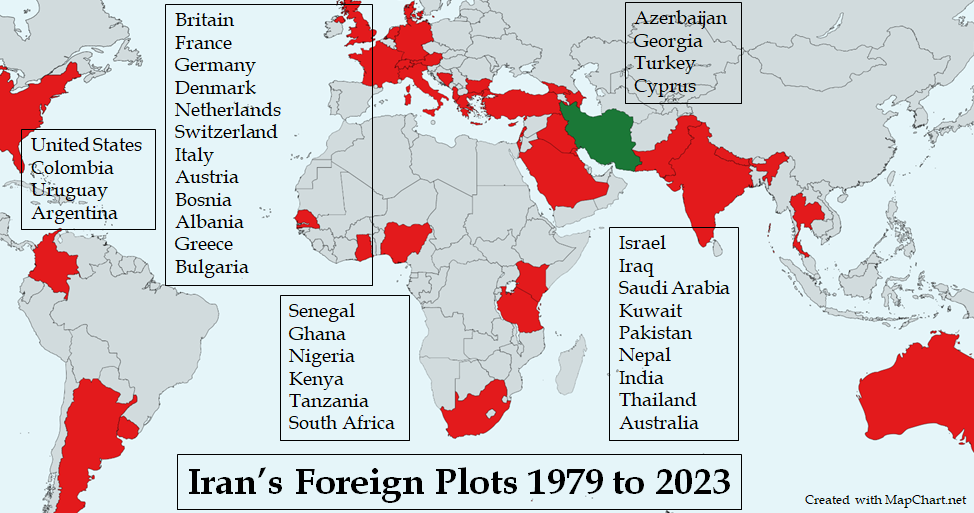
The following are alleged or confirmed plots by Iran, according to the United Nations, the United States and other foreign governments; some attacks were confirmed in confessions by the perpetrators.
Timeline of Iran’s Assassinations
Dec. 7, 1979: Shahriar Shafiq, the former shah’s nephew and a captain in the royal navy, was killed after being shot twice in the head by the Muslim Liberation Group, a previously unknown group, outside his mother’s home in city France. Ayatollah Sadeq Khalkhali, the notorious “Hanging Judge,” claimed that Iran was responsible. It was the first known assassination by Iran after the 1979 revolution.
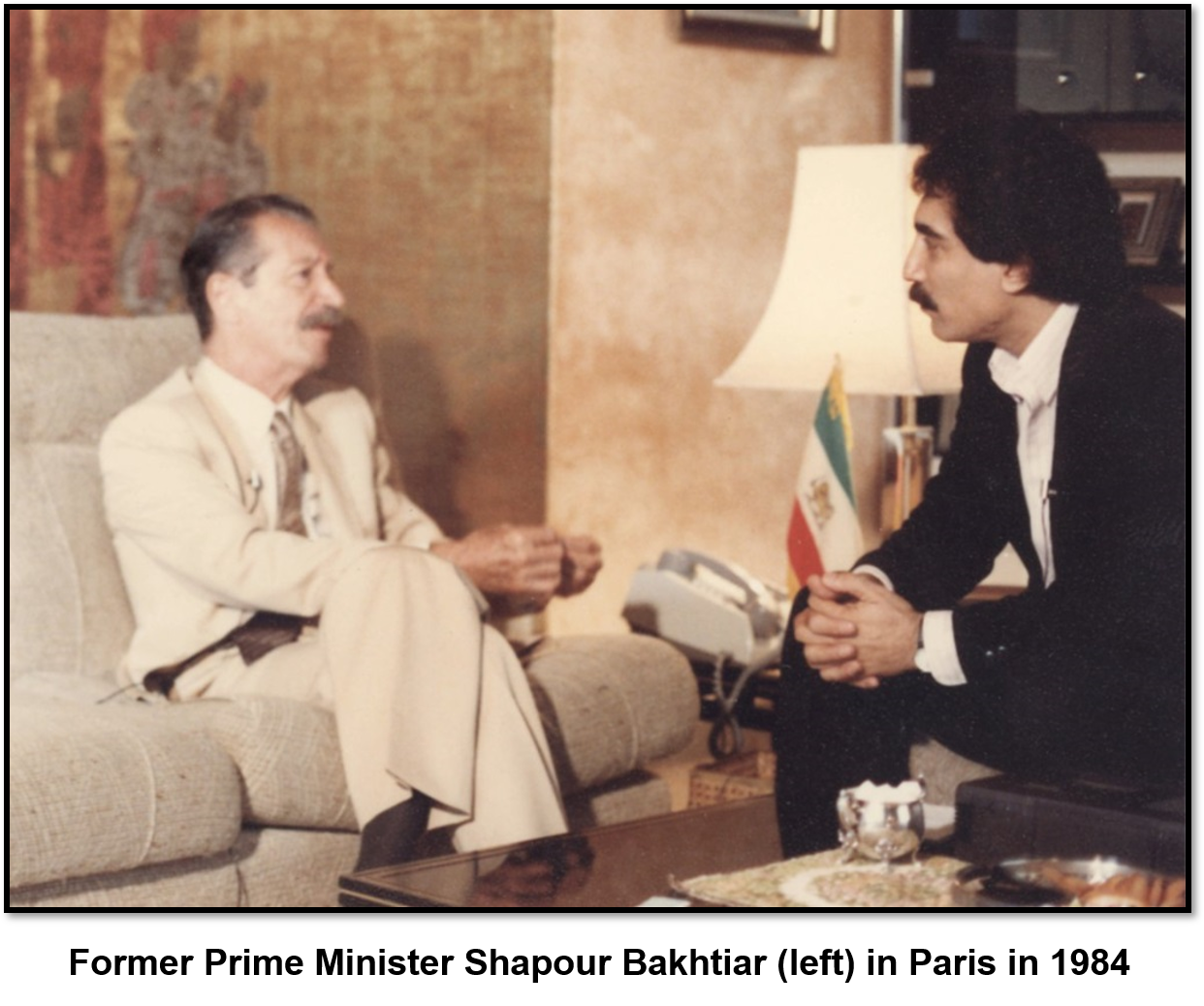 July 18, 1980: Shapour Bakhtiar, Iran’s last prime minister during the monarchy, was targeted in a failed assassination attempt outside his residence in a Paris suburb. The hit squad, which included five members, was put on trial in July 1990. Two were soon pardoned and released; the leader, a Lebanese national, was flown to Tehran. He claimed the release was part of a deal to release three French hostages in Iran.
July 18, 1980: Shapour Bakhtiar, Iran’s last prime minister during the monarchy, was targeted in a failed assassination attempt outside his residence in a Paris suburb. The hit squad, which included five members, was put on trial in July 1990. Two were soon pardoned and released; the leader, a Lebanese national, was flown to Tehran. He claimed the release was part of a deal to release three French hostages in Iran.
July 22, 1980: Ali Akbar Tabatabaei, the president of the Iran Freedom Foundation and a former diplomat at the Iranian embassy in Washington, was shot in front of his home in Bethesda, Maryland. The assassin was Dawud Salahuddin, an American Muslim convert, who fled to Tehran (Salahuddin was later associated with the disappearance of former FBI agent Robert Levinson in 2007).
Oct. 23, 1983: Two hundred forty-one U.S. Marines were killed by two trucks loaded with explosives that crashed into the Marines barracks in Beirut, Lebanon. It was the highest single-day death toll for the U.S. military since the Vietnam War. The Islamic Jihad Organization, a group allegedly backed by Hezbollah and the IRGC, claimed responsibility.
June 14-30, 1985: TWA Flight 847 was hijacked in Greek airspace by Lebanese Hezbollah, which demanded the release of 700 Shiite Muslims from Israeli custody. The hijackers killed a U.S. Navy diver and threatened to kill Jewish passengers. Iran provided logistical support to the hijackers, according to the National Counterterrorism Center.
Dec. 27, 1985: Gunmen opened fire and threw hand grenades in coordinated attacks at Rome and Vienna airports. At least 16 people were killed and more than 100 were injured. The perpetrators targeted people near ticket counters for El Al, Israel’s national airline. They were reportedly supporters of the militant Palestinian leader Abu Nidal. Some were allegedly trained in Isfahan, Iran.
December 1985-September 1986: Twenty civilians died and 255 were injured in a series of 13 bombings or attempted bombings in Paris over nine months. The attacks were perpetrated by an unknown group that demanded the release of three Middle Eastern terrorists. Iran was involved in the bombings, French authorities later alleged.
June 1986: Oil installations in Kuwait were bombed by Shiite militants allegedly tied to Iran, according to the State Department in January 1988. Five bombs exploded near crude oil tank farms and a well near Kuwait City.
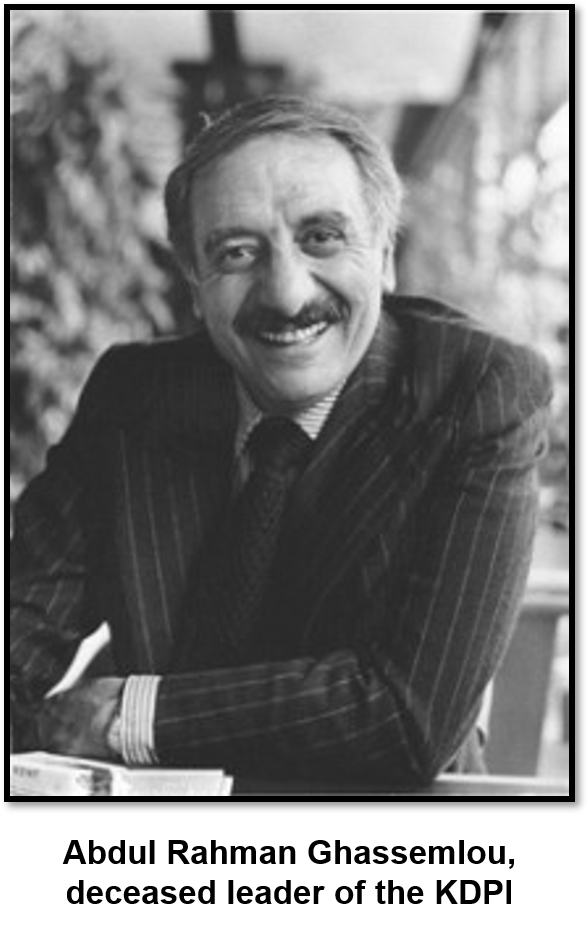 July 18, 1987: Amirhussein Amir Parvis, a cabinet minister the shah’s government, was injured in a car bombing in London. While in exile, he served as chairman of the National Movement for Iranian Resistance. A group called the Guardians of the Islamic Revolution claimed responsibility. “We are responsible and we will kill all the . . . monarchists,” a caller from the group said.
July 18, 1987: Amirhussein Amir Parvis, a cabinet minister the shah’s government, was injured in a car bombing in London. While in exile, he served as chairman of the National Movement for Iranian Resistance. A group called the Guardians of the Islamic Revolution claimed responsibility. “We are responsible and we will kill all the . . . monarchists,” a caller from the group said.
July 13, 1989: Abdul Rahman Ghassemlou, the leader of the Kurdish Democratic Party of Iran (KDPI), was killed in Vienna, Austria. Three Iranian officials met with Ghassemlou on diplomatic pretenses and allegedly shot him with three bullets at close range. Two of Ghassemlou’s aides were also killed. In November 1989, Austrian authorities issued an arrest warrant for the three officials, but they had returned to Iran. The KDPI had supported the overthrow of the shah in 1979 but turned against the Islamic Republic after Khomeini demanded the group hand over its weapons.
April 24, 1990: Kazem Rajavi, the spokesperson for the Mujahdeen e-Khaleq (MEK), was assassinated allegedly by Iranian agents near Geneva, Switzerland. He was the first revolutionary ambassador to the United Nations before resigning in 1980 and joining the National Council of Resistance of Iran (NCRI). In 2006, a Swiss judge issued an arrest warrant for Ali Fallahian, the Iranian intelligence minister from 1989 to 1997, for the murder. In August 2020, the United States imposed visa restrictions on 13 Iranians that it claimed had also been involved in the assassination.
Aug. 6, 1991: Shapour Bakhtiar, the former Iranian prime minister, was assassinated allegedly by two Iranian intelligence agents, Vakili Rad and Mohammad Azadi, in Suresnes, France. The agents had allegedly posed as electronics businessmen in order to gain access to his residence. The agents reportedly crushed his larynx and stabbed him multiple times in the chest. Bakhtiar’s secretary, Soroush Katieh, was also allegedly murdered. The alleged perpetrators were arrested by Swiss police and extradited to France.
March 17, 1992: Twenty people were killed and 252 wounded by a suicide bombing outside the Israeli Embassy in Buenos Aires, Argentina. Islamic Jihad, an organization linked to Hezbollah, claimed responsibility for the attack, but an Israeli investigation in 2003 claimed that “the highest levels of the Iranian regime… had in fact authorized Hezbollah to carry it out.”
July 24, 1992: Salman Rushdie, the British-Indian author of the controversial The Satanic Verses, was allegedly targeted by three Iranians; two were employed at the Iranian Embassy in London and a third was on a student visa. The British Foreign Office expelled the three Iranians. Rushdie became a target after Ayatollah Ruhollah Khomeini, the revolutionary leader, issued a fatwa in February 1989 calling on Muslims around the world to kill Rushdie.
Sept. 17, 1992: Four Iranian Kurdish dissidents were killed by gunmen at a Greek restaurant in Berlin, Germany allegedly by Iranian agents. Sadiq Sherefkandi, Secretary General of the KDPI, was among those killed. In October 1993, a German court convicted one Iranian – an alleged Iranian intelligence officer named Abdolraham Banihashemi – and three Lebanese nationals. In April 1997, the same court issued an international arrest warrant for former Iranian intelligence minister Ali Fallahian who the court claimed had ordered the assassination.
July 18, 1994: Ninety-five were killed and 200 wounded in an explosion outside the Argentine-Israeli Mutual Association. Islamic Jihad claimed responsibility for the attack, but Argentine intelligence allegedly concluded in 2004 that a 21-year Hezbollah operative carried out the attack with Iranian logistical support. The bombing was the deadliest terrorist attack conducted in Argentina. In 2006, Argentine authorities issued an international arrest warrant for Ali Fallahian who it claimed had orchestrated the operation. In 2007, INTERPOL placed Ali Fallahian, four other Iranian officials and one Hezbollah member on its most wanted list for their alleged involvement in the bombing.
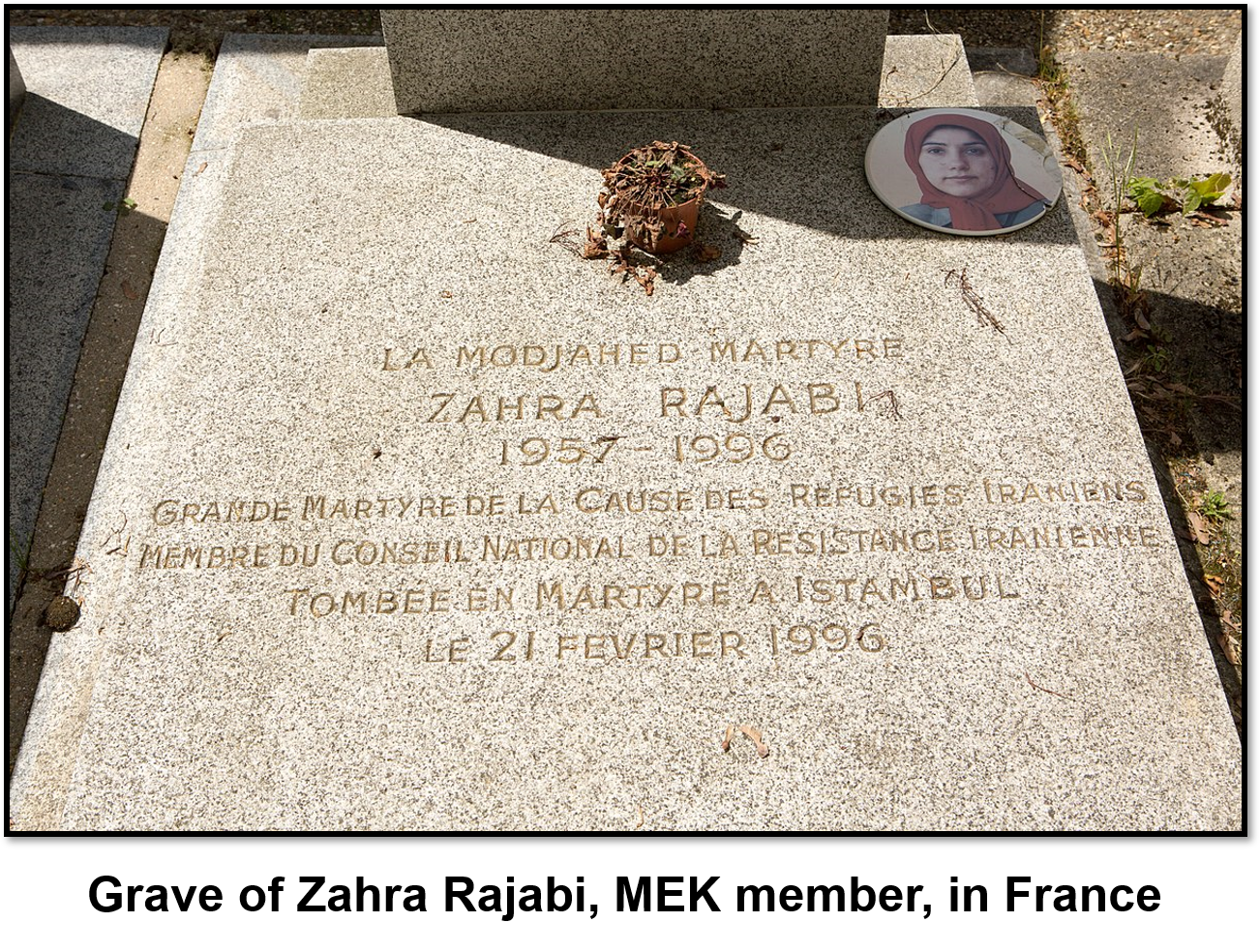 January - May 1996: Five Iranian exiles – two in Turkey, two in Pakistan and one Baghdad – were allegedly assassinated by Iran in a five-month period, Western government sources told the Chicago Tribune. Three exiles were members of the MEK, including Zahra Rajabi who shot to death in her apartment in Istanbul, Turkey on February 20, 1996.
January - May 1996: Five Iranian exiles – two in Turkey, two in Pakistan and one Baghdad – were allegedly assassinated by Iran in a five-month period, Western government sources told the Chicago Tribune. Three exiles were members of the MEK, including Zahra Rajabi who shot to death in her apartment in Istanbul, Turkey on February 20, 1996.
June 25, 1996: Nineteen U.S. service members were killed, and 500 people were injured by an explosion near Khobar Towers, a U.S. Air Force housing complex in Saudi Arabia. The bombers detonated a truck packed with 5,000 pounds of explosions parked near the building. Hezbollah al Hejaz, the militant group’s branch in Saudi Arabia, claimed responsibility for the attack. In 2001, a U.S. federal grand jury chose not to indict any Iranians for the attack but alleged that “an Iranian military officer” directed the operation. In December 2006, a U.S. federal judge ruled that Iran was responsible for the bombing and ordered it to pay $254 million to the families of the Americans who died in the attack.
May 2008: The Israeli embassy in Baku, Azerbaijan was allegedly targeted by Hezbollah operatives who planned to explode car bombs near the embassy. The attack was foiled by Azerbaijani authorities. In 2012, Azerbaijan's government claimed that the IRGC had ordered attacks against “U.S., Israeli and other Western states’ embassies and embassies’ employees. It arrested 22 Azerbaijanis whom it claimed had been trained by Iran as spies and assassins.
September 2009: Jamshid Sharmahd, the leader of a small Iranian opposition group named the “Kingdom Assembly of Iran,” was allegedly targeted by an Iranian hit man in Glendora, California. In 2010, British counterterrorism police warned the U.S. Embassy in London that Sharmahd had been “targeted by the Iranian regime” in a leaked cable. In July 2020, Iran said that it had detained Sharmahd while he was traveling on a business trip to India via Dubai. Tehran accused him of bombing a mosque in Shiraz in 2008.
May 16, 2011: Hassan al Qahtani, a security official working at Saudi Arabia’s consulate in Karachi, Pakistan was shot by a man on a motorbike. The assassin was reportedly a member of a Shiite dissident group, Sapih Mohammad, linked to the IRGC Qods Force, a Saudi official told The Washington Post.
 September 29, 2011: Adel al Jubeir, Saudi Arabia’s ambassador to the United States, was the target of a failed plot to bomb a restaurant where he would be dining. On October 11, the U.S. Treasury sanctioned four senior IRGC Qods Force operatives and a naturalized U.S. citizen, Manssor Arbabsiar, in connection with the plan.
September 29, 2011: Adel al Jubeir, Saudi Arabia’s ambassador to the United States, was the target of a failed plot to bomb a restaurant where he would be dining. On October 11, the U.S. Treasury sanctioned four senior IRGC Qods Force operatives and a naturalized U.S. citizen, Manssor Arbabsiar, in connection with the plan.
Arbabsiar, who held both U.S. and Iranian passports, had lived in the United States for some 30 years and sold used cars in Corpus Christi Texas. Arbabsiar told a prison psychiatrist that he spent a lot of money on expensive cars, alcohol and women. One woman put him in touch with a member of a Mexican drug gang who was actually a Drug Enforcement Agency informant. Arbabsiar held meetings in Mexico and Iran to plan the assassination. He was eventually arrested at John F. Kennedy International Airport on September 29, 2011 after being denied entry to Mexico. He told authorities that his cousin, an IRGC general, was directing the operation. Arbabsiar said he was going to pay $1.5 million to the Los Zetas gang to kill Jubeir. In May 2013, after pleading guilty, Arbabsiar was sentenced to 25 years in prison for one count of conspiracy to commit murder-for-hire, and one count of conspiracy to commit an act of terrorism transcending national boundaries.
Jan. 25, 2012: Michael Lotem, the Israeli ambassador to Azerbaijan, and other Israelis were the targets of an assassination plot foiled by Azerbaijani security forces. Three locals were reportedly recruited by a gangster with alleged connections to Iranian intelligence. Azerbaijan’s Security Ministry said Balqardash Dadashov allegedly promised three Azerbaijanis $150,000 to kill Lotem along with a rabbi and a woman at a Chabad center in Baku. Weapons, including a sniper rifle with a silencer, pistols and plastic explosives, had been smuggled into the country for the attack.
Feb. 13, 2012: Israeli embassy personnel were reportedly targeted in coordinated bombing attempts in New Delhi, India and Tbilisi, Georgia. In India, a motorcyclist put a sticky bomb on a minivan owned by the Israeli Embassy. In Georgia, a bomb was placed on an Israeli car but failed to detonate. Israeli officials said the operations appeared to be directed by Tehran. “In all these cases, the elements behind the attacks were Iran and its proxy, Hezbollah,” Prime Minister Benjamin Netanyahu said.
Feb. 14, 2012: Itzhak Shoham, the Israeli ambassador to Thailand, and other diplomats, were allegedly the targets of a botched assassination attempt in Thailand. The plot was uncovered after a cache of homemade explosives – similar to those used in India and Georgia the previous day – mistakenly exploded in an upscale neighborhood in Bangkok. Saeid Moradi tried to flee the scene but encountered police. He threw a bomb that ended up blowing off his legs. Seven Iranians were implicated in the plot. In February 2012, Madani Seyed Mehrded was sentenced to three months in jail for overstaying his visa. In August 2013, a Thai court sentenced Moradi to life in prison for attempted murder and carrying explosives. Mohammad Kharzei received 15 years for carrying explosives. The other suspects reportedly fled the country.
March 2012: An attack on Israeli targets was reportedly foiled by Turkish authorities. Four IRGC Qods Force operatives had entered Turkey to carry out the operation, according to the State Department.
March 14, 2012: The U.S. and Israeli embassies as well as British oil giant BP in Baku, Azerbaijan, were allegedly targets of locals working for the IRGC. Azerbaijan arrested 22 people in connection with the plot. The IRGC “wanted to set a special contingent in Azerbaijan under a cover of religious activity,” Azerbaijan’s National Security Ministry said in a statement. The suspects had rifles, grenades, detonators and “special equipment for spying.”
June 2012: U.S., Israeli, Saudi and British nationals were allegedly targeted by two Iranians - Ahmad Mohammed and Sayed Mousavi - who planned to bomb buildings in Nairobi and Mombasa, Kenya. The Iranians were members of the Qods Force, Kenyan authorities claimed. Authorities discovered 33 pounds of explosive materials in their possession. In May 2013, a Kenyan court convicted the two Iranians sentenced to life in prison on terrorism charges. In 2019, Iran’s ambassador to Kenya was under criminal investigation by Kenya for his alleged role in the plot.
July 18, 2012: Six Israeli tourists and a Bulgarian bus driver were killed in a suicide bombing at Sarafovo Airport in Burgas, Bulgaria. Israel blamed Hezbollah and Iran for the attack. Bulgarian Interior Minister Tsvetan Tsvetanov said the bomber was carrying a fake Michigan driver’s license.
Late July 2012: A synagogue in Sophia, Bulgaria was allegedly surveilled by an IRGC Qods Force operative.
December 2012: U.S. and Israeli nationals were targeted by three Nigerians allegedly working for Iran. In February 2013, Nigerian authorities arrested three Nigerians whom it claimed Iran had paid to spy “on public places and prominent hotels frequented by Americans and Israelis to facilitate attacks.” Iran also allegedly trained one of the Nigerians in weapons and explosives, Nigeria claimed.
April 13, 2013: The Israeli embassy in Katmandu, Nepal was surveilled by Mohsin Khosravian, an Iranian man carrying a fake Israeli passport. Khosravian was arrested after Israeli embassy officials noticed him observing the embassy.
Late April 2013: Jadidi Sohrab and Hamzeh Dolab Ahmad, two Iranian diplomats, were expelled from Bosnia and Herzegovina for espionage and links to terrorism. Israeli intelligence determined they were members of Iran’s Ministry of Intelligence and Security (MOIS).
May 2013: Bosnia expelled two Iranian diplomats, Hamzeh Dolab Ahmad and Jadidi Sohrab, who were allegedly intelligence officers.
Jan. 8, 2015: The Israeli embassy in Montevideo, Uruguay appeared to be the target of an attempted bombing. A small explosion occurred near a trade center building housing the Israeli embassy. Police found a partially detonated device allegedly connected to someone at the Iranian embassy. A senior Iranian diplomat was expelled in April 2015 for alleged involvement in the plot.
December 2015: Mohammad Reza Kolahi Samadi, a member of the MEK, was shot in his apartment in Almere in the Netherlands. Samadi had reportedly sought asylum using a fake name, Ali Motamed. Iran had sentenced him to death in absentia for his involvement in the 1981 bombing of the Islamic Republican Party’s headquarters in Tehran, which killed dozens of officials. In January 2019, Dutch intelligence said Iran hired a middleman to kill Samadi.
Iranian bomber Mohammad Reza Kolahi Samadi assassinated in the Netherlands https://t.co/W64lKv2fUd pic.twitter.com/S1On09WrFD
— Het Parool (@parool) May 26, 2018
February 2016: Philippine authorities reportedly thwarted an Iranian plot to hijack a Saudi Arabian Airlines plane at Manila’s airport. A local newspaper said that 10 operatives departed Iran to carry out the mission.
July 2016: Reinhold Robbe, the former head of the German-Israel Friendship Society, and David Rouach, an Israeli-French professor, was the target of an assassination plot, according to German prosecutors. The IRGC Qods Force paid Haidar Syed-Naqfi, a Pakistani national living in Germany, at least 2,052 euros ($2,429), to conduct surveillance on Robbe along with other Israeli and Jewish institutions and individuals in Paris. Syed-Naqfi was arrested in July 2016. In March 2017, he was sentenced to four years and three months in prison for spying “against Germany and another NATO member” on behalf of Iranian intelligence.
November 2016: The Israeli embassy in Nairobi was allegedly targeted by two Iranian nationals. In December 2016, the Iranians and their Kenyan driver were arrested and charged by Kenyan authorities for with taking video clips “for the use in the commission of a terrorist act.”
Nov. 8, 2017: Ahmad Mola Nissi, a founder of an opposition group, the Arab Struggle Movement for the Liberation of Ahvaz (ASMLA), was shot outside of his home in The Hague. In January 2019, the Dutch intelligence said Iran had hired middleman to carry out Nissi’s killing and that of another opposition figure, Reza Kolahi Samadi, who was killed in 2015.
January 2018: Israeli and Jewish targets in Germany were reportedly being surveilled by 10 suspected IRGC Qods Force operatives. German media reported that police raided locations in the states of Baden-Württemberg, North Rhine-Westphalia, Bavaria and Berlin but did not arrest anyone.
March 28, 2018: MEK members in Albania were the target of a planned attack by the IRGC Qods Force, Albania’s police director, Ardi Veliu, announced on October 23, 2019. Two Iranian suspects had been arrested in Tirana in March 2018 but were released due to lack of evidence.
June 30, 2018: An annual rally hosted by an umbrella opposition group, the NCRI, was the target of a bombing thwarted by Belgian authorities. Some 25,000 people attended the “Free Iran 2018 – The Alternative” event in Vellepinte, just outside of Paris. High profile speakers included former Speaker of the U.S. House of Representatives Newt Gingrich and Rudy Giuliani, a former mayor of New York City, President Donald Trump’s attorney. The NCRI is considered to be the MEK’s political arm.
A married Belgian couple identified as Amir S., 38, and Nasimeh N., 33, of Iranian heritage were found with 500 grams of TATP explosive and a detonator when stopped in Woluwe-Saint-Pierre, Belgium by special forces. They were charged with an “attempt at terrorist murder and preparing a terrorist crime.” Three other suspects were detained in France.
 An unnamed Iranian diplomat, who worked for Tehran’s mission to Austria, was also detained in Germany in connection to the foiled attack. On October 10, German authorities named the diplomat as Asadollah Assadi. He was stripped of his diplomatic status and was extradited to Belgium, where he was sentenced to 20 years in prison. In July 2022, Belgium ratified a treaty with Iran that could allow Assadi to finish serving his sentence in Iran.
An unnamed Iranian diplomat, who worked for Tehran’s mission to Austria, was also detained in Germany in connection to the foiled attack. On October 10, German authorities named the diplomat as Asadollah Assadi. He was stripped of his diplomatic status and was extradited to Belgium, where he was sentenced to 20 years in prison. In July 2022, Belgium ratified a treaty with Iran that could allow Assadi to finish serving his sentence in Iran.
Oct. 30, 2018: Habib Jabor, the leader of the ASMLA faction based in Copenhagen, was reportedly the target of an assassination plot, Denmark’s intelligence agency said on October 30, 2018. A Norwegian citizen of Iranian descent had taken photographs and watched Jabor’s home in Ringsted, a town nearly 37 miles southwest of Copenhagen. The suspect was arrested in Sweden on October 21 and extradited to Denmark.
Nov. 14, 2019: Masoud Molavi Vardanjani, an Iranian dissident, was shot dead on an Istanbul street. Turkish and U.S. officials said that Iran appeared to be behind the assassination. “Given Iran’s history of targeted assassinations of Iranian dissidents and the methods used in Turkey, the United States government believes that Iran’s Ministry of Intelligence and Security (MOIS) was directly involved in Vardanjani’s killing,” a senior Trump administration official told Reuters in April 2020.
In February 2021,Turkish authorities arrested Mohammad Reza Naserzadeh for his role in the assassination Vardanjani. Naserzadeh was an Iranian working in the civil registry department at the Iranian consulate in Istanbul. He allegedly forged travel documents for Ali Esfanjani, the primary planner of Vardanjani’s assassination.
Sept. 13, 2020: Lana Marks, the U.S. ambassador to South Africa, was reportedly an Iranian assassination target, Politico reported. Politico claimed Iran was considering several options as retaliation for the U.S. killing of General Qassem Soleimani in January 2020.
President Donald Trump warned Iran that the U.S. response to an attack would be overwhelming.
According to press reports, Iran may be planning an assassination, or other attack, against the United States in retaliation for the killing of terrorist leader Soleimani, which was carried out for his planning a future attack, murdering U.S. Troops, and the death & suffering...
— Donald J. Trump (@realDonaldTrump) September 15, 2020
...caused over so many years. Any attack by Iran, in any form, against the United States will be met with an attack on Iran that will be 1,000 times greater in magnitude!
— Donald J. Trump (@realDonaldTrump) September 15, 2020
Majid Takht Ravanchi, Iran’s U.N. ambassador, said that Trump’s allegation was baseless and that his threat violated the U.N. charter. “The irresponsible policies and unlawful practices of the United States pose a serious threat to international peace and security. Therefore, it is incumbent upon the United Nations Security Council to demand that the United States put an end to its threats and unfettered policies and hold that country accountable for its wrongful acts,” Ravanchi wrote in a letter to the U.N. Secretary General Antonio Guterres.
Iranian Foreign Minister Mohammad Javad Zarif accused Trump of “leaking a new false alarm.”
The habitual liar bamboozled @realdonaldtrump into assassinating ISIS' enemy #1 by raising a false alarm.
Now he's trying to sucker him into mother of all quagmires by leaking a new false alarm.
-Politico source: “US officials"
-Trump source: “press reports”
Time to wake up. pic.twitter.com/2oBbbsWnxN— Javad Zarif (@JZarif) September 15, 2020
April 2021: Swedish authorities arrested an Iranian couple in the Stockholm area that were allegedly planning to murder Aron Verständig, the then-head of the Official Council of Swedish Jewish Communities, and Saskia Pantell, who was serving as the interim head of the Zionist Federation in Sweden. A third target, also Jewish, was not publicized. The couple, Mahdi Ramezani and Fereshteh Sanaeifarid, had pretended to be Afghan refugees when they arrived in Sweden in 2015. Sweden deported them in 2022 after the plot was uncovered. “We have strong belief that they were here on a mission on behalf of Iran,” deputy chief prosecutor Hans Ihrman said. “They were seen here in Sweden as a very severe security threat. And that's the reason why they were expelled, even if we couldn't prosecute them.”
July 13, 2021: The Department of Justice charged four Iranians with conspiring to kidnap an Iranian American journalist living in Brooklyn. The four men were charged with conspiracy to kidnap, violating U.S. sanctions on Iran, money laundering and bank and wire fraud. They faced a lifetime in prison, if convicted on all charges. The indictment, unsealed in a New York federal court, identified the conspirators by name. Alireza Shavaroghi was an intelligence official living in Iran who oversaw the operation. Mahmoud Khazein, Kiya Sadeghi and Omid Noori were “intelligence assets” who worked under Farahani.
The indictment also named a female accomplice: Niloufar Bahadorifar, age 46, who allegedly “provided financial services” to the plotters while living in California. She was arrested on July 1 and arraigned before a federal judge on July 8. Bahadorifar was charged with violating U.S. sanctions on Iran, money laundering, and bank and wire fraud. The four other Iranians “remain at large,” the U.S. Attorney’s Office for the Southern District of New York said in a statement on July 13.
The Justice Department did not identify the Iranian American journalist. But Masih Alinejad – a Voice of America contractor and fierce critic of Iran’s compulsory dress code – told The New York Times that she was the intended kidnapping target.
Sept. 27 2021: One man was arrested in the Cypriot capital Nicosia in connection with a plot to assassinate Israeli businessmen living in Cyprus. The suspect was reportedly an Azeri male in his late 30s who was carrying a Russian passport. A pistol, ammunition and a silencer were found in the car he was traveling in when arrested by Cypriot authorities.
Oct. 14, 2021: A former Iranian soldier was the target of a plot to kidnap him and bring him back to Iran. Turkish authorities detained two alleged Iranian agents and six Turkish citizens in connection with the plan. The group reportedly tried to bribe the veteran's wife to assist them and threatened to harm members of her family in Iran if she refused. The suspects were arrested in Turkey’s eastern province of Van. One of the agents had been apprehended while trying to sneak into the veteran’s house.
Nov. 7, 2021: Five people were detained by local authorities in Ghana, Senegal and Tanzania for allegedly planning attacks against Israeli tourists and businesspeople on behalf of Iran, Israel’s Channel 12 reported. Local authorities reportedly were acting based on Western intelligence. The five suspects had reportedly been recruited by the IRGC Qods Force, trained in Lebanon, and sent to the respective African countries under the pretext that they were religious students.
Nov. 14, 2021: Colombian Defense Minister Diego Molano announced that authorities had detained and deported two Hezbollah-linked operatives planning to commit unspecified criminal acts. The deportations had occurred in September 2021.
Military intelligence later said that Hezbollah was surveilling Israeli and American businessmen in Colombia and U.S. diplomats in Bogotá. One target for assassination, a former Israeli intelligence officer, was reportedly evacuated to Tel Aviv. Israeli media reported that Iran's Qods Force, not Hezbollah, was responsible for the plot.
Nov. 28, 2021: An Iranian man, Mohammed Saeid Golabi, was arrested by Kenyan authorities for allegedly planning attacks against both Israeli and Kenyan individuals. “We have enough reason to believe that he has been working with those terror groups,” an officer from Kenya’s anti-terrorism police unit said.
Jan. 12, 2022: Four Israeli women and one man, all Jewish immigrants from Iran, were charged with spying for the Islamic Republic. An Iranian operative who called himself “Rambod Namdar” recruited the Israelis on Facebook and communicated with them on WhatsApp. One woman photographed the former U.S. Embassy in Tel Aviv and a shopping center. Another woman, who was paid $5,000 for her work, encouraged her son to join a secret service unit. She sent photos of his military ID and dog tags to Namdar. She also photographed the U.S. Embassy in Jerusalem. “Iranian intelligence agents make extensive use of the Internet, and there has been a rise recently in these kinds of approaches to Israeli citizens,” Israel’s domestic security service, the Shin Bet, said.
June 12, 2022: Turkish authorities exposed an Iranian plot to kidnap or kill Israeli tourists in Turkey. Israeli security officials had tipped off their Turkish counterparts.Israel urged its citizens to leave or avoid the Turkish capital, Istanbul. The Israeli National Security Council raised the threat level for Istanbul to four, the highest possible.
Some of the Israelis who were targeted were evacuated due to an imminent threat. In one case, an Israeli couple was reportedly forced to leave all their belongings in her hotel before they were driven to the airport in an Israeli security convoy.
On June 23, Turkish authorities reportedly arrested eight people, including five Iranians, in Istanbul in connection to the plot. Local press reported that Iran had sent agents who posed as businessmen, students and tourists. They rented apartments and hotel rooms and planned to set up a network of agents.
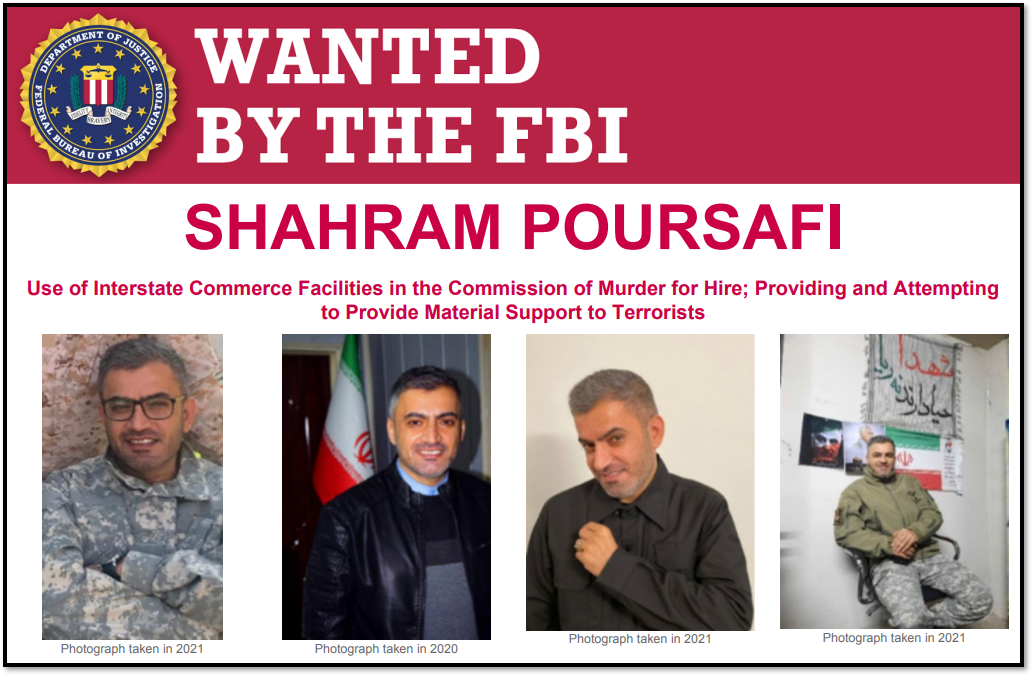 Aug. 10, 2022: The U.S. Justice Department announced charges against an IRGC member for plotting to murder John Bolton, who served as national security advisor to President Donald Trump from 2018 to 2019. Shahram Poursafi, 45, planned the operation, “likely in retaliation” for the U.S. assassination of General Qassem Soleimani, the commander of Iran’s elite Qods Force. Soleimani was killed in a U.S. drone strike in Baghdad in early 2020.
Aug. 10, 2022: The U.S. Justice Department announced charges against an IRGC member for plotting to murder John Bolton, who served as national security advisor to President Donald Trump from 2018 to 2019. Shahram Poursafi, 45, planned the operation, “likely in retaliation” for the U.S. assassination of General Qassem Soleimani, the commander of Iran’s elite Qods Force. Soleimani was killed in a U.S. drone strike in Baghdad in early 2020.
Poursafi offered $250,000 to an unnamed individual to “eliminate” Bolton. The amount was later upped to $300,000. Poursafi also mentioned that he had a second job for $1 million. The Justice Department did not specify who the target was beyond a former “high-ranking” Trump Administration official. Former Secretary of State Mike Pompeo was reportedly a target of that plot. Former Secretary of Defense Mark Esper was also targeted by Iran.
Nov. 14, 2022: Azerbaijan said that it had arrested five locals who spied on behalf of Iranian intelligence. One collected information about the country’s oil sector while working as a captain in the Caspian Sea oil fleet. Two other people surveilled military equipment and energy infrastructure. Another provided information about Azerbaijan’s military, politics and society. And a fifth individual reportedly located Azerbaijani citizens in Iran.
Jan. 27, 2023: The United States indicted three men for plotting to assassinate Masih Alinejad, a Brooklyn-based activist critical of the Iranian government. The men, members of an eastern European criminal organization, were working for people based in Iran. The plot reflected Iran’s determination to silence critics, even in the United States. The plotters faced up to 40 years in prison on murder-for-hire and money laundering charges. One faced an additional five years for possessing a firearm with an obliterated serial number. The Department of Justice indicted the following men:
- Rafat Amirov, a leader of the criminal organization who resides in Iran and was arrested in the United States in January 2023
- Polad Omarov, a leader of the criminal organization who resides in eastern Europe and was arrested in the Czech Republic in January 2023
- Khalid Mehdiyev, a member of the criminal organization who resides in New York and was arrested in the United States in July 2022
Feb. 14, 2023: In 2022, the Australian Security Intelligence Organization exposed Iranian efforts to surveil a dual citizen who had protested in Australia over the death of Mahsa Amini in Iran in September 2022, Australian Home Affairs Minister Clare O’Neil revealed in a speech. She also warned against foreign surveillance and interference. “We don’t just need to disrupt these operations, but deter future ones by imposing costs on their sponsor through outing them, where possible,” O’Neil asserted. “It is perfectly legal for anyone in Australia to criticize a foreign regime, as tens of thousands of people across the country have been doing in response to events in Iran.” But she added that Australia “absolutely will not tolerate, under any circumstances… attempts by foreign regimes to disrupt peaceful protests, encourage violence or suppress views.”
March 28, 2023: Greek police arrested two men who were allegedly plotting attacks against Israeli and Jewish targets, including a Kosher restaurant in Athens, on behalf of Iran. The two men, aged 27 and 29, were reportedly born in Iran but were Pakistani nationals. They had entered Greece illegally from Turkey months earlier. Another operative based in Iran, who reportedly promised to pay the pair for carrying out the attacks, was charged in absentia. “Their aim was not only to cause the loss of life of innocent citizens, but also to undermine the sense of security in the country, while hurting public institutions and threatening [Greece’s] international relations,” the police said.
Israel’s Mossad assisted Greek authorities with the investigation, “which revealed that the infrastructure that operated in Greece is part of an extensive Iranian network run from Iran and spanning many countries,” according to a statement from Prime Minister Benjamin Netanyahu’s office.
May 11, 2023: Iranian state agencies, through an intermediary, had directed a German-Iranian dual national to set fire to a synagogue in Germany in November 2022, according to German prosecutors. They charged Babak J. with attempted arson after he set a school building connected to a synagogue on fire.
June 25, 2023: The Revolutionary Guards had reportedly planned an attack against Israelis and Jewish people in Cyprus, according to Israel and Cypriot outlets. Intelligence groups in Cyprus, with support from the United States and Israel, prevented the attack. On June 29, Mossad revealed that it had detained a leader of the plot inside Iran. In a video of the interrogation, Yousef Shahbazi Abbasalilo confessed that he had worked with the IRGC Intelligence Organization. The network reportedly targeted an Israeli businessman, a Chabad House, hotels, and entertainment venues linked to Israeli tourism. Iranians, Pakistanis, and Cypriots were reportedly involved in the plot.
August 2023: The IRGC had reportedly attempted to assassinate Itzik Moshe, a Georgian Jew and head of Beit Israel, three times in Tbilisi, according to The Media Line. The plots included two stabbing attempts and a failed shooting. Georgian security forces foiled all three attempts. Moshe’s organization promotes relations between former Soviet countries and Israel. “In one of the investigations, it was discovered that they are blaming me for bringing the State of Israel into the region since I was the first representative in the Caucasus in the ‘90s,” Moshe said in an interview. “The order was, according to the investigation, to murder me at the entrance of the office so that they could show the blood together with the flag of Israel,” he added.
Photo credits: Marine Barracks via U.S. Marine Corps (Public Domain), Qassem Soleimani via Ali Khamenei Website (CC by 4.0), Rahman Ghassemlou via Wikimedia Commons (Public Domain), Bakhtiar via IRTV (CC By 4.0), Rajabi by Pierre-Yvews Beaudouin via Wikimedia Commons (CC By-SA 4.0), Jubeir by Foreign, Commonwealth and Development Office via Flickr (CC by 2.0), Lana Marks via U.S. Embassy and Consulates in South Africa (Public Domain); Soleimani via Tasnim News Agency (CC BY 4.0)
Andrew Hanna was a research analyst at the U.S. Institute of Peace. Garrett Nada is the managing editor of The Iran Primer.
